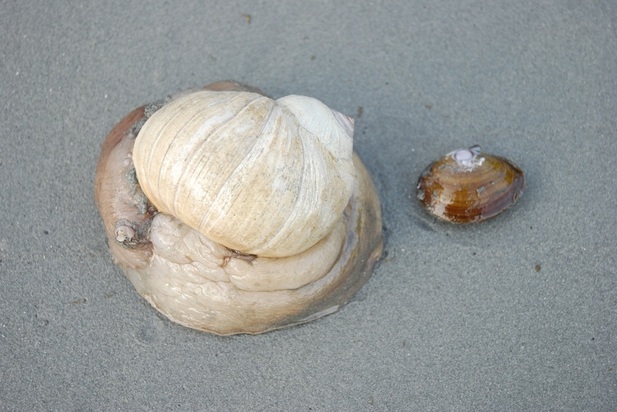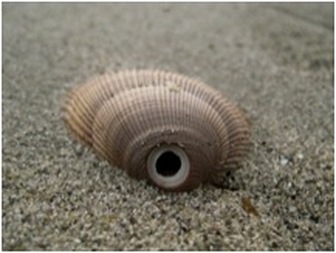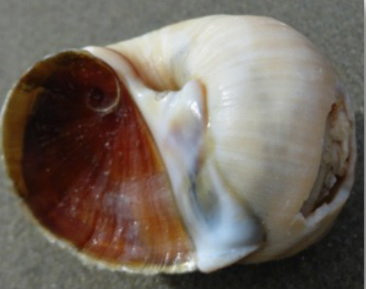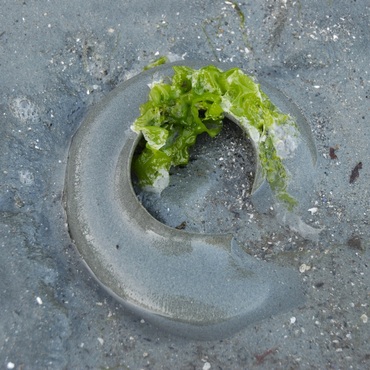Lewis's Moonsnail, moon snail, northern moon snail, western moon shell, Lewis's moon shell • Euspira lewisii, Polinices lewisii, Lunatia lewisii
Top: this moonsnail was found in the process of drilling a hole into a bivalve (the hole is visible at the top of the shell). Photo by Kelly Fretwell. Middle left: a round hole with a bevelled edge drilled into a shell is the mark of a moonsnail attack. Photo by Kelsey Collins. Middle: like other marine snails, when the animal is fully retracted into its shell the opening (aperture) is covered by a hard shield (operculum). Photo by Sarein Basi-Primeau. Right: moonsnail egg casings look like curved sheets of sand packed together ("sand collars"), and can often be found in the shallow waters of sandy beaches. Photo by Kelly Fretwell.
Identification
Lewis' moonsnail is by far the largest and the most common moonsnail species found on the BC Central Coast. Its shell, measuring up to 14 cm across, has a distinctive globular shape, and is a creamy-white colour on the outside with a brown interior. A brown operculum covers the wide aperture. The animal's body is a soft, smooth, transparent tan or brown-grey colour. When out of the shell, the body can spread out to cover a large area, including most of the shell.
Habitat & Range
Lewis's moonsnail is most commonly found in in silty and sandy intertidal and subtidal areas, to a depth of 50 m. It often burrows into the sand for protection or to pursue prey. This species ranges along the coast of North America from southern Alaska to southern California, and is also found off the coast of Japan.
Similar Species
Drake's moonsnail (Euspira draconis), the pale northern moonsnail (Euspira pallida), and the Arctic moonsnail (Cryptonatica affinis) all have similarly shaped and coloured shells. However Drake's is mostly found in California and has a much larger hole between the shell whorls (the umbilicus); the northern species only reaches 4 cm and is less rounded; and the Arctic species has a white operculum and reaches just 2.5 cm. Small Lewis's moonsnails could potentially provide some identification difficulty, and those looking for extra help may find this more detailed distinction useful.
Intriguing Info
The thin egg casing laid by Lewis' moonsnails, called a sand collar, is rounded by the curvature of the animal's shell as the casing is laid. The casing is made up of sand and eggs held together by a jelly-like substance, with the eggs sandwiched between sand layers. Eggs are laid from April to September, and will stay in this collar until they hatch 6 weeks later.
This animal drills a characteristic bevelled-edged hole through the shell of its prey, using its radula (visible in the bottom left photo). These holes are found most often in some clam species, but also in other species such as purple olives.
Lewis' moonsnail is by far the largest and the most common moonsnail species found on the BC Central Coast. Its shell, measuring up to 14 cm across, has a distinctive globular shape, and is a creamy-white colour on the outside with a brown interior. A brown operculum covers the wide aperture. The animal's body is a soft, smooth, transparent tan or brown-grey colour. When out of the shell, the body can spread out to cover a large area, including most of the shell.
Habitat & Range
Lewis's moonsnail is most commonly found in in silty and sandy intertidal and subtidal areas, to a depth of 50 m. It often burrows into the sand for protection or to pursue prey. This species ranges along the coast of North America from southern Alaska to southern California, and is also found off the coast of Japan.
Similar Species
Drake's moonsnail (Euspira draconis), the pale northern moonsnail (Euspira pallida), and the Arctic moonsnail (Cryptonatica affinis) all have similarly shaped and coloured shells. However Drake's is mostly found in California and has a much larger hole between the shell whorls (the umbilicus); the northern species only reaches 4 cm and is less rounded; and the Arctic species has a white operculum and reaches just 2.5 cm. Small Lewis's moonsnails could potentially provide some identification difficulty, and those looking for extra help may find this more detailed distinction useful.
Intriguing Info
The thin egg casing laid by Lewis' moonsnails, called a sand collar, is rounded by the curvature of the animal's shell as the casing is laid. The casing is made up of sand and eggs held together by a jelly-like substance, with the eggs sandwiched between sand layers. Eggs are laid from April to September, and will stay in this collar until they hatch 6 weeks later.
This animal drills a characteristic bevelled-edged hole through the shell of its prey, using its radula (visible in the bottom left photo). These holes are found most often in some clam species, but also in other species such as purple olives.
Watch a video of a live moon snail:
References
Cowles, D. (2005). Euspira lewisii (Gould, 1847). Invertebrates of the Salish Sea. Rosario Beach Marine Laboratory. Accessed 23/06/2013
Harbo, R. M. (1999). Whelks to whales: Coastal marine life of the Pacific Northwest. Madeira Park, BC: Harbour Publishing. P. 108
Lamb, A., and Hanby, B. (2005). Marine Life of the Pacific Northwest. Madeira Park, BC: Harbour Publishing. P. 235
Authors and editors of page
Kelly Fretwell and Brian Starzomski (2013).
Cowles, D. (2005). Euspira lewisii (Gould, 1847). Invertebrates of the Salish Sea. Rosario Beach Marine Laboratory. Accessed 23/06/2013
Harbo, R. M. (1999). Whelks to whales: Coastal marine life of the Pacific Northwest. Madeira Park, BC: Harbour Publishing. P. 108
Lamb, A., and Hanby, B. (2005). Marine Life of the Pacific Northwest. Madeira Park, BC: Harbour Publishing. P. 235
Authors and editors of page
Kelly Fretwell and Brian Starzomski (2013).







